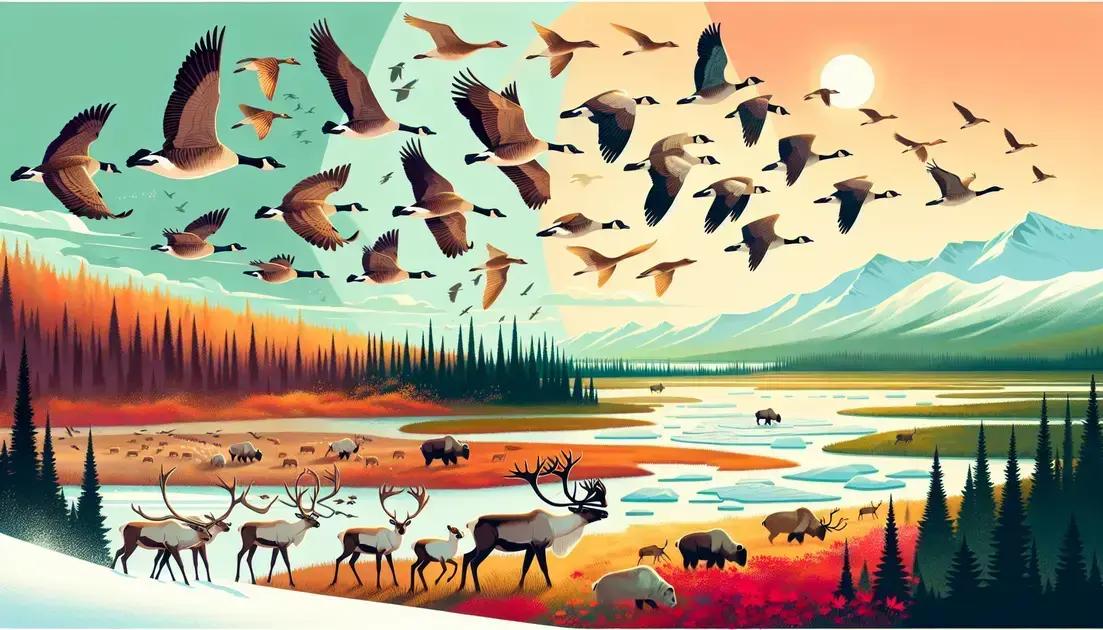The changing seasons in Canada are a precious phenomenon that affects wildlife, with climate change impacting migrations and life cycles. Protecting these natural variations is crucial to ensuring biodiversity and sustainability in the country.
The changing seasons in Canada are a sight to behold for any visitor. With each change in the weather, the country reveals new landscapes, from the gentle beauty of spring to the white blanket of winter. In this article, we’ll explore the four seasons and the unique experiences each one offers, as well as events and festivals that celebrate this natural diversity.
Seasonal landscapes
Canada is famous for its seasonal landscapes stunning landscapes that change dramatically with each season. First in spring, flowers begin to bloom, coloring the fields and parks with vibrant shades of pink, yellow and green. Snow-capped mountains begin to melt, revealing views of crystal-clear lakes.
Summer: The Splendor of Nature
In summer, the country transforms into an outdoor paradise. Forests become dense and green, and cities fill with festivals and outdoor events. Lakes and river beaches attract visitors looking for water fun, while hiking trails offer spectacular views of nature.
Autumn: A Color Palette
Autumn brings a veritable palette of colors. The leaves on the trees change from green to warm shades of orange, red and yellow. This is the perfect time to go hiking and admire the scenery, as well as visit wineries and enjoy the seasonal harvests. Photographs taken during this season are always stunning.
Winter: A Winter World
Winter in Canada is magical. The mountains are covered in snow, creating ideal places for skiing, snowboarding and other winter activities. Cities are adorned with festive lights, and winter events such as festivals and fairs attract locals and tourists alike. The snowy landscapes offer a tranquil beauty, perfect for those who appreciate nature at its most serene.
Wildlife Migration at Stations in Canada

THE wildlife migration It is a fascinating phenomenon that occurs all over the world, and in Canada, it is especially visible during seasonal changes. At first, many species of migratory animals move vast distances in search of food and better weather conditions.
Species on the Move
Among the most notable species in Canada are migratory birds such as geese and ducks, which travel south during the winter and return in the spring. There are also mammals, such as caribou, that undertake long migrations in search of pasture and water. These journeys can involve hundreds of kilometers and are essential for the survival of the species.
Impact of Seasons
Seasonal changes profoundly affect wildlife migration. During the spring, rising temperatures and melting snow bring new food sources. In the fall, temperatures drop and animals seek fresh shelter and food, prompting them to migrate. These migrations are not only instinctual, but also influenced by climatic and ecological factors.
Conservation and Challenges
Wildlife migration faces a number of challenges, including habitat loss and climate change. Urbanization and the destruction of natural ecosystems can disrupt migration routes, making conservation of natural areas crucial. Above all, research and habitat restoration projects are important to ensure that species can continue their annual migration and preserve biodiversity.
Climate impacts in Canada
You climate impacts are visible in many regions of the world, and Canada is no exception. Changing climate conditions have affected the country's seasons, fauna and flora in a variety of ways. With rising temperatures and changing weather patterns, the impacts are already evident in many aspects of nature and daily life.
Changes in the Seasons
First and foremost, the first consequence of climate change is the change in seasons. Some regions are experiencing shorter winters and warmer summers. These changes can affect the life cycle of plants and animals, influencing the flowering, reproduction and migration of different species.
Impacts on Fauna and Flora
As the climate changes, many species face challenges in adapting. Animals that depend on the cold, such as polar bears, are finding their habitats threatened. At the same time, species that are comfortable in warmer climates may expand northward, altering existing ecosystems. Plants are also adapting, with some species flowering earlier or moving to a new location.
Social and Economic Consequences
Climate change also has social and economic consequences. Agriculture, which depends on stable seasons, may be affected, leading to food insecurity. In addition, the tourism industry, which depends on climate conditions, may face challenges when snow and weather patterns change. Therefore, it is essential to consider how society adapts to these changes and what measures can be taken to mitigate these impacts.
The Importance of Protecting Nature in Canada
Canada’s changing seasons and the effects of climate on its environment are phenomena that teach us much about the interconnectedness of nature. Wildlife migration and climate impacts also highlight the importance of preserving ecosystems. Protecting biodiversity and natural habitats is essential to ensuring that species can thrive in all seasons.
As climate conditions change, we need to be aware of the consequences this has for both wildlife and society. It is crucial now to promote sustainable practices and engage the community in conservation efforts to protect what is so valuable.


